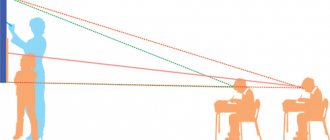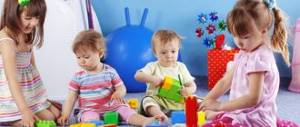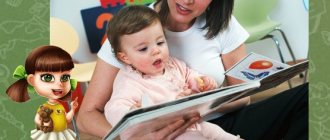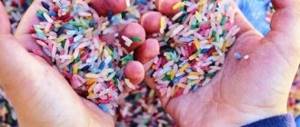Presentation “Artistic and aesthetic development in preschool educational institutions according to Federal State Educational Standards for Preschool Education” presentation
Slide 1
“Artistic and aesthetic development of preschool children in the context of the implementation of the Federal State Educational Standard for Education” Completed by senior teacher Khvostenko I.V.
Slide 2
1 question. How does the Federal State Educational Standard for Education reveal artistic and aesthetic development?
Slide 3
Artistic and aesthetic development involves the development of prerequisites for the value-semantic perception and understanding of works of art (verbal, musical, visual, natural world; the formation of an aesthetic attitude towards the surrounding world; the formation of elementary ideas about types of art; the perception of music, fiction, folklore; stimulating empathy for characters works of art; implementation of independent creative activities of children (visual, constructive-model, musical, etc.).
Slide 4
Formation of interest in the aesthetic side of the surrounding reality, aesthetic attitude towards objects and phenomena of the surrounding world, works of art; nurturing interest in artistic and creative activities. Development of children's aesthetic feelings, artistic perception, figurative ideas, imagination, artistic and creative abilities. Development of children's artistic creativity, interest in independent creative activities (visual, constructive-model, musical, etc.); satisfying children's need for self-expression. Introduction to art. Development of emotional sensitivity, emotional response to literary and musical works, the beauty of the surrounding world, works of art. Introducing children to folk and professional art (verbal, musical, visual, theatrical, architecture) through familiarization with the best examples of domestic and world art; developing the ability to understand the content of works of art. Formation of elementary ideas about types and genres of art, means of expression in various types of art. Main goals and objectives.
Slide 5
Visual activity. Development of interest in various types of visual activities; improving skills in drawing, modeling, appliqué, and applied arts. Cultivating emotional responsiveness when perceiving works of fine art. Fostering the desire and ability to interact with peers when creating collective works.
Slide 6
Constructive modeling activity. Introduction to design; development of interest in constructive activities, familiarity with various types of constructors. Developing the ability to work collectively, unite your crafts in accordance with a common plan, and agree on who will do what part of the work.
Slide 7
Musical activities. Introduction to the art of music; development of prerequisites for value-semantic perception and understanding of musical art; formation of the foundations of musical culture, familiarization with elementary musical concepts and genres; nurturing emotional responsiveness when perceiving musical works. Development of musical abilities: poetic and musical ear, sense of rhythm, musical memory; formation of song and musical taste. Cultivating interest in musical and artistic activities, improving skills in this type of activity. Development of children's musical and artistic creativity, implementation of independent creative activity of children; satisfying the need for self-expression
Slide 8
2question. What types of children's activities are there?
Slide 9
Game (including plot-role-playing game, game with rules and other types). Communicative (communication and interaction with adults and peers). Cognitive and research (studying objects of the surrounding world and experimenting with them). Perception of fiction and folklore. Productive (drawing, modeling, appliqué, etc.). Musical (perception and understanding of the meaning of musical works, singing, musical and rhythmic movements, playing children's musical instruments). Motor (mastery of basic movements). Self-service and basic household work (indoors and outdoors). Construction from various materials including constructors modules paper and natural material.
Slide 10
Question 3. What tasks are set for artistic and aesthetic development?
Slide 11
Tasks for artistic and aesthetic development. Younger age: Develop artistic perception, cultivate responsiveness to music and singing, works of fine art and literature that are understandable to children. Examine illustrations to works of children's literature with children. Develop the ability to answer questions based on the content of pictures. -Introduce folk toys: Dymkovo, Bogorodskaya, matryoshka, Vanka-Vstanka and others, appropriate to the age of the children. Draw children's attention to the nature of toys (cheerful, funny, etc.), their shape, color design. To develop children’s aesthetic senses, artistic perception, to promote a positive emotional response to literary and musical works, the beauty of the surrounding world, works of folk and professional art (book illustrations, handicrafts, household items, clothing).
Slide 12
Encourage children to appreciate works of art. To introduce elementary means of expressiveness in different types of art (color, sound, shape, movement, gestures), to differentiate between types of art through artistic image. Prepare children for visiting a puppet theater, exhibition of children's works, etc. Develop aesthetic perception; draw children's attention to the beauty of surrounding objects (toys), natural objects (plants, animals), and evoke a feeling of joy. To develop an interest in visual arts. Learn to depict simple objects and phenomena in drawing, modeling, and appliqué, conveying their figurative expressiveness. Include in the process of examining an object the movement of both hands on the object, grasping it with your hands. Evoke a positive emotional response to the beauty of nature, works of art (book illustrations, handicrafts, household items, clothing). Learn to create both individual and collective compositions in drawings, modeling, and appliqué.
Slide 13
Middle age: Introduce children to the perception of art, develop interest in it. Encourage the expression of aesthetic feelings, the manifestation of emotions when viewing objects of folk and decorative art, listening to works of musical folklore. Introduce children to the professions of an artist, artist, composer. Encourage to recognize and name objects and phenomena of nature and the surrounding reality in artistic images (literature, music, fine arts). Learn to distinguish between genres and types of art: poetry, prose, riddles (literature), songs, dances, music, paintings (reproductions), sculpture (fine arts), buildings and structures (architecture). Learn to identify and name the basic means of expressiveness (color, shape, size, rhythm, movement, gesture, sound) and create your own artistic images in visual, musical, and constructive activities. Introduce children to architecture. Form the idea that the houses in which they live (kindergarten, school, other buildings) are architectural structures; houses are different in shape, height, length, with different windows, with different numbers of floors, entrances, etc.
Slide 14
Arouse interest in various buildings located around the kindergarten (houses in which the child and his friends live, school, cinema). Draw children's attention to the similarities and differences of different buildings, encourage them to independently highlight parts of the building and its features. Strengthen the ability to notice differences in buildings that are similar in shape and structure (shape and size of entrance doors, windows and other parts). Encourage children's desire to depict real and fairy-tale buildings in drawings and applications. Organize a visit to the museum (together with parents), talk about the purpose of the museum. Develop interest in visiting puppet theaters and exhibitions. To consolidate children's knowledge about books and book illustrations. Introduce the library as a storage center for books created by writers and poets. Introduce works of folk art (nursery rhymes, fairy tales, riddles, songs, round dances, chants, products of folk arts and crafts). Cultivate a caring attitude towards works of art.
Slide 15
Continue to develop children's interest in visual arts. Evoke a positive emotional response to the offer to draw, sculpt, cut and paste. Continue to develop aesthetic perception, figurative ideas, imagination, aesthetic feelings, artistic and creative abilities. Continue to develop the ability to examine and examine objects, including with the help of hands. Enrich children's ideas about fine art (illustrations for works of children's literature, reproductions of paintings, folk decorative art, small sculpture, etc.) as the basis for the development of creativity. Teach children to identify and use means of expression in drawing, modeling, and appliqué. Continue to develop the ability to create collective works in drawing, modeling, and appliqué. Teach to be friendly when evaluating the work of other children.
Slide 16
Older age: Continue to develop an interest in music, painting, literature, folk art. To develop aesthetic feelings, emotions, aesthetic taste, aesthetic perception of works of art, to develop the ability to highlight their means of expression. Learn to correlate the artistic image and means of expression that characterize it in different types of art, select material and aids for independent artistic activity. To develop the ability to highlight, name, group works by type of art (literature, music, fine arts, architecture, theater). Continue to introduce the genres of visual and musical art. To develop the ability to identify and use in one’s visual, musical, and theatrical activities the means of expression of different types of art, to name materials for different types of artistic activity.
Slide 17
Introduce works of art (I. Shishkin, I. Levitan, V. Serov, etc.) and the depiction of native nature in the paintings of artists. Expand your understanding of graphics (its means of expression). Introduce the work of illustrators of children's books (Yu. Vasnetsov, E. Charushin, I. Bilibin, etc.). Continue to introduce architecture. To consolidate the knowledge that there are buildings with different purposes: residential buildings, shops, theaters, cinemas, etc. Develop observation skills, learn to carefully examine buildings, notice their characteristic features, variety of proportions, designs, decorating details. To introduce the concepts of “folk art”, “types and genres of folk art”. Expand children's understanding of folk art, folklore, music and crafts. To form in children a caring attitude towards works of art. Continue to develop children's interest in visual arts.
Slide 18
Enrich sensory experience by developing the organs of perception: vision, hearing, smell, touch, taste; consolidate knowledge about the basic forms of objects and natural objects. Develop aesthetic perception, teach to contemplate the beauty of the world around us. In the process of perceiving objects and phenomena, develop mental operations: analysis, comparison, likening (what it looks like), establishing similarities and differences between objects and their parts, identifying common and individual characteristics, generalization.
Slide 19
In the process of perceiving objects and phenomena, develop mental operations: analysis, comparison, likening (what it looks like), establishing similarities and differences between objects and their parts, identifying common and individual characteristics, generalization. Learn to convey in an image not only the basic properties of objects (shape, size, color), but also characteristic details, the relationship of objects and their parts in size, height, location relative to each other. Develop the ability to observe, peer (listen) into phenomena and objects of nature, notice their changes (for example, how the shape and color of slowly floating clouds change, how the corolla of a flower gradually opens in the morning and closes in the evening, how the illumination of objects changes in the sun and in the shade). Learn to convey in an image the basic properties of objects (shape, size, color), characteristic details, the relationship of objects and their parts in size, height, location relative to each other.
Slide 20
Develop the ability to observe natural phenomena, notice their dynamics, shape and color of slowly floating clouds. Improve visual skills and abilities, develop artistic and creative abilities. Develop a sense of shape, color, proportions. Continue to introduce folk arts and crafts (Gorodets, Polkhov - Maidan, Gzhel), expand ideas about folk toys (matryoshka dolls - Gorodets, Bogorodskaya; spillikins). Introduce children to national arts and crafts (based on regional characteristics); with other types of decorative and applied arts (porcelain and ceramics, small sculptures). Develop children's decorative creativity (including collective creativity). -Develop the ability to organize your workplace, prepare everything necessary for classes; work carefully, use materials sparingly, keep the workplace clean, and put it in order after finishing work. Continue to improve children’s ability to examine work (drawings, modeling, applications), enjoy the results achieved, notice and highlight expressive solutions to images.
Slide 21
CROSSWORD
Slide 22
TREE BLUE CLAY N A G O S T O V O GOLD I G R U S H K A G O N C H A R S K U L P T U R A P R Y L K A 1 2 3 4 5 6 7 8 9
Slide 23
Question 4. What should a child have at the stage of completing preschool education?
Slide 24
Targets at the stage of completion of preschool education. the child masters the basic cultural methods of activity, shows initiative and independence in various types of activities - play, communication, cognitive and research activities, design, etc.; is able to choose his occupation and participants in joint activities; the child has a positive attitude towards the world, towards different types of work, other people and himself, has a sense of self-esteem; actively interacts with peers and adults, participates in joint games. Able to negotiate, take into account the interests and feelings of others, empathize with failures and rejoice in the successes of others, adequately expresses his feelings, including a sense of self-confidence, tries to resolve conflicts; the child has a developed imagination, which is realized in various types of activities, and above all in play; the child knows different forms and types of play, distinguishes between conventional and real situations, knows how to obey different rules and social norms;
Slide 25
the child has a fairly good command of oral speech, can express his thoughts and desires, can use speech to express his thoughts, feelings and desires, construct a speech utterance in a communication situation, can highlight sounds in words, the child develops the prerequisites for literacy; the child has developed gross and fine motor skills; he is mobile, resilient, masters basic movements, can control and manage his movements; the child is capable of volitional efforts, can follow social norms of behavior and rules in various types of activities, in relationships with adults and peers, can follow the rules of safe behavior and personal hygiene; the child shows curiosity, asks questions to adults and peers, is interested in cause-and-effect relationships, and tries to independently come up with explanations for natural phenomena and people’s actions; inclined to observe and experiment.
Slide 26
Question 5. How can you combine several activities into a single whole?
Slide 27
Integration. Combining different types of activities with one thematic content creates opportunities for creative understanding of the topic and its most complete reflection using means of expression specific to a particular type of artistic activity; provides the child with deep knowledge and emotional experience of images created in music, literature, and games. The formation of a harmoniously, comprehensively developed personality of a child, ensuring the effective development of artistic and creative abilities, is determined by the interconnected use of all means of aesthetic education and a variety of artistic and creative activities. And in order to establish a relationship between knowledge, you need to use an integrated approach to the learning process of preschoolers.
Slide 28
Integration is a complex structural process that requires: teaching children to consider any phenomena from different points of view; developing the ability to apply knowledge from various fields in solving a specific creative problem; developing in preschool children the ability to independently conduct creative research; developing their desire to actively express themselves in some kind of creativity.
Slide 29
Question 6. How does the subject-developing environment influence artistic and aesthetic development?
Slide 30
All children are talented, so it is necessary to notice, feel this talent in time and try, as early as possible, to give the opportunity to demonstrate it in practice. It is necessary to create a basis for his creativity. The more a child sees and hears, the more attentive and productive the activity of his imagination will become. To complete assignments in class, our kindergarten teachers offer children a variety of materials: simple and colored pencils, watercolors, gouache, wax crayons, felt-tip pens, plasticine, clay, salt dough, different types of construction sets.
Slide 31
In their daily activities, educators reinforce with children the knowledge, skills and abilities acquired in classes. For this purpose, all age groups have materials and tools for artistic and aesthetic development, visual aids, literary works describing the beauty of nature, seasons, etc. The content of visual aids, albums and literary works are accessible to children and are designed for their age characteristics; it is possible to develop on their basis the ability to see, admire and depict the beauty of the world around them.
Slide 32
The design of theater, music, arts and crafts corners, and the condition of the equipment meet hygienic and pedagogical requirements, taking into account the age and level of development of children. The educational subject environment in the group is based on a person-oriented model of interaction between adults and children. The subject environment includes a variety of teaching tools (didactic, game, educational materials are used), the development prospects of children, their differentiated needs are taken into account, and contribute to the development of a comprehensively developed personality. All conditions have been created for the full upbringing and education of children, the selection of teaching materials and aids, their placement and storage are appropriate for the age of the children, are varied and are designed for all types of activities provided for by the program.
Slide 33
Creative workshop
Slide 34
THANK YOU FOR YOUR ATTENTION!
Consultation for parents
It is important for parents to seek professional advice regarding raising their children. During such consultations on the artistic and aesthetic development of children, it is necessary to emphasize that children's creativity must be encouraged in all possible ways. It is advisable to give some advice:
- the child must be interested in the process of drawing;
- You shouldn’t limit your child’s creativity;
- You can't be afraid of experiments.
The time a child spends in a preschool educational institution should include classes in artistic and aesthetic development. A child's personality is largely formed through creative activity. The task of teachers and parents in this area is not only to develop certain creative skills, but also to instill taste, develop the concept of aesthetics, and introduce the child to culture. It is important to maintain a balance: creativity must go hand in hand with the development of cognitive abilities, acquiring new knowledge and ideas about the world, as well as the development of collective and individual work skills. In addition, it is important that the parent and teacher “work” together in this area, supporting and stimulating the child to be creative.





